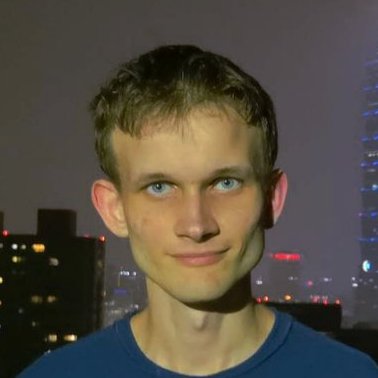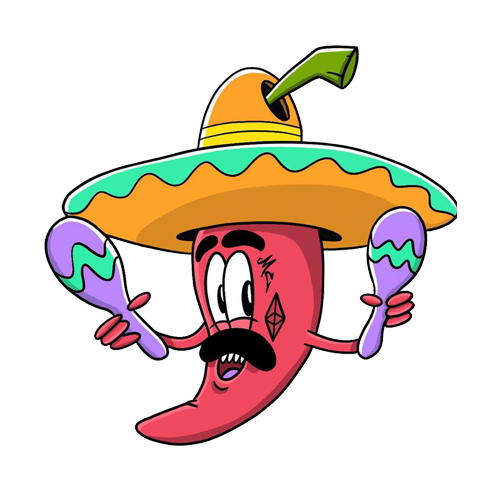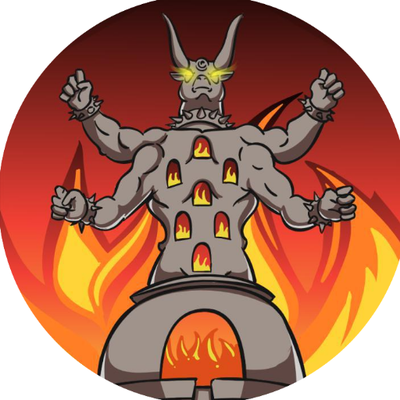A Decentralized Autonomous Organization (a.k.a. DAO), is a new type of company whose management is hardcoded directly into a set of smart contracts. DAOs can enhance group coordination, record feedback from members, and provide financial incentives for users to complete tasks that further the group’s objectives. DAOs create a self-sustaining system, via community feedback, and economic incentives in order to meet a common goal. But, some envision DAOs of the future as having autonomy, making higher level decisions, and functioning somewhat like an organism. In the future DAOs may work with, or even compete with humans, consuming economic bandwidth to survive, as in the post-singularity novel Accelerando.
Below, I’ll explore: the origination of the DAO concept, how DAOs differ from traditional organizations, DAOs that exist right now, and what DAOs might become in the future…
Where Did the dao concept originate?
Daniel Larimer first proposed the concept of a “Decentralized Autonomous Company” (DAC) in the Sept 2013 article here. He compared owning BTC, as similar to owning shares in a decentralized company, whose goal was to perform a service to the market. The goal of a for-profit DAC is to maximize value and minimize costs. He implemented his DAC tech ideas into Bitshares a year later.
DAO’s envisioned by Vitalik in 2013
In a series of blogs, Vitalik Buterin envisioned a time when companies could be run with less intervention from humans. He asks “even if we still need human beings to perform certain specialized tasks, can we remove the management from the equation instead?”
Vitalik sees the type of distributed computing found in Bitcoin necessary to prevent a DAO from being shutdown or maliciously manipulated for an individual members gain.
Bootstrapping A Decentralized Autonomous Corporation: Part-1
In part two of the series, Vitalik examines how autonomous agents might explore the world around it. An agent would need to absorb data around it to make decisions. It would also need to know what type of data is valuable in the world that it lives in.
Bootstrapping A Decentralized Autonomous Corporation: Part-2
In part three, he writes about the possible use cases of these organizations, as well as a specific example of an identity verifying DAO.
Bootstrapping A Decentralized Autonomous Corporation: Part-3
A New type of Organizational Structure

Instead of being built in a hierarchical structure (left image) like a traditional company, a DAO is organized so its stakeholders share in the decision making power and revenue.
Traditional pyramidal company structures allow for the consolidation of power, and carry the potential for abuse. The top of the pyramid receives the majority of financial benefits and is provided with the majority of the decision making authority.
How DAOs Automate Trust and FAIRNESS
DAOs improve group coordination, because they remove the need for trust between group members. They allow users to easily collaborate, without the need to know each other. Decision making is based on group consensus (i.e on-chain voting) and is transparent. DAOs provide feedback mechanisms allowing for user feedback, creating a fair playing field.
DAOs create an infrastructure of cooperation. They aim to be meritocratic. This means a user’s value is based on what they have contributed to the organization. This value is determined via user ratings, tasks completed, and interactions with other members. This type of organizational structure ensures that no member is too influential. Members are financially rewarded in shares, equity, and voting power if their contribution benefits the goals of the organization.
DAOs allow a group to work symbiotically for financial gain. They can trustlessly share the equity of the combined work. DAOs allow users to invest in an idea, even before venture capital gets the chance.
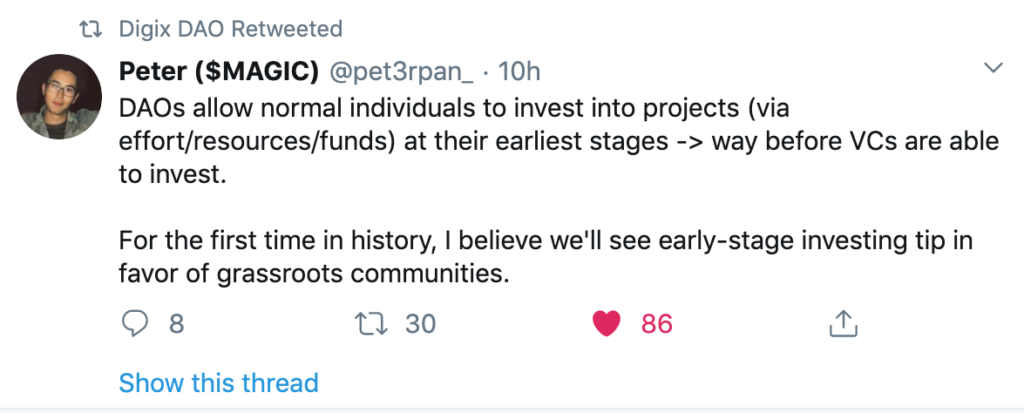
Becoming ALive: Decentralized Autonomous Organisms
In their current state, DAOs are far from autonomous. They can replace lower level management by enhancing human cooperation and executing simple managerial tasks. Humans are still required for complex decision making. If in the future, DAOs can make higher level decisions, perform goal seeking behavior, and have some autonomy, would they be considered a living organism?
Ismail Malik founder of Blockchain Labs envisions a future for DAOs, where high level decisions are handled by “executive decision trees”. DAOs might perform “oracle calls” out to humans, to receive input on certain tasks. They could be self improving, and possibly equipped with evolutionary DNA, only calling for human input when a customer has a disagreement with the AI. Malik thinks multiple DAOs could link together to form something like an organism. They could cooperate to build a complex, interdependent, system. But, this future might be a dystopian vision if AIs are competing with humans for a piece of the economic pie.
Current Examples of Working DAOS
Meta Cartel is a DAPP incubator, providing resources and social capital to new projects, such as the gas station network. They focus on application development and ETH mass adoption, providing “grant funding and operational support” to early teams.
Users can receive shares in MetaCartel by completing tasks, or donating ETH to the DAO. Shares are non-fungible, and non transferable. They are non-transferable because they don’t want users to sell voting rights!
Meta-cartel relies heavily on pre-screening, which could be why they haven’t yet had major sources of contention between members. Recently, they have been experimenting in micro-finance, NFTs, and are moving towards a goal of creating a revenue generating DAO.
One idea I found interesting in the video above, was about child DAOs. I liked the idea of how a group of members could form child DAOs in-order to complete specific tasks, then dissolve them when the task was completed.
Moloch Dao is focused on providing grants to fund the “Ethereum public goods infrastructure” with an emphasis on helping the transition from ETH 1.0 to 2.0. Moloch is a simple DAO. It is essentially a multi-sig wallet with voting, and rage-quit functionality.
“Rage quit” allows users to destroy their stock and voting rights, in exchange for access to the underlying capital.
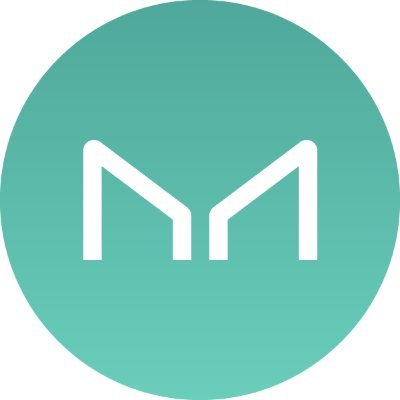
Maker Dao – MakerDAO allows users to create CDPs (collateralized debt position) in order to withdraw a stablecoin called DAI, as a loan. Lenders can earn interest on funds by contributing to a pool, which is provided to borrowers. Maker (MKR) tokens allow holders to have a share in governance and vote on stability rate changes.

Kyber Dao – This DAO was created to help users manage parts of the Kyber protocol including: network fees, burning ratios and reserve incentives. KNC holders are allowed to submit and vote on proposals. This DAO runs using Blockstack.

Bitshares – Bitshares is a decentralized exchange and a platform which can facilitate development of Decentralized Autonomous Companies. It is the first known DAO, or DAC. It was created by Dan Larimer, who first proposed the concept here.
Bitshares can automate parts of the human management process, by encoding it into an immutable set of smart contracts . It allows elections of delegates and witnesses to submit proposals and vote on upgrades. Each stakeholder’s power is proportional to the amount of BTS it has staked.
How to create Your own DAO
There are several options for users who want to create their own DAOs. They include Aragon, DaoStack, and Colony.
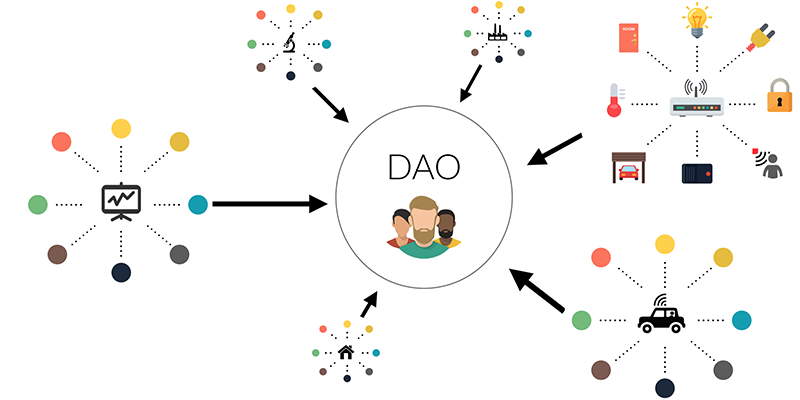
Aragon is an open-source blockchain project which allows users to build and manage their own DAOs. It uses Ethereum smart contracts to create, manage, and share in the proceeds of a group-run organization. It allows for voting, accounting, payroll, assignments, etc.
DaoStack is modular, open-source software which allows for the governance of a DAO. It allows stakeholders to come together, create, and manage a company which is shared by its contributors.
Colony is smart contract framework which provides the organizational structure for ownership, and financial management. It allows users to customize their DAO with smart contract modules. Colony believes that “new paradigms of occupation and income will emerge” from the implementation of these new types of organizations.
Necessary functions of a DAO
A particular feature-set is needed to allow a group of users to trustlessly work together. They include:
On-Chain Voting: This allows for transparency in all decisions, as they are all recorded on the blockchain. Users know that they aren’t being misled, as all decisions are public record.
Proposals: Users with voting rights can create proposals which other users can vote on.
Shares: This allows users to share in the equity created by the organization. They can be rewarded in shares for completing tasks, or they just buy their shares outright.
Reputation Systems: These systems allows users, unknown to each other, to gauge the usefulness and trustworthiness of other members.
Accounting: All financial transactions are done completely on-chain. All financial activity is completely transparent to other users within the DAO.
Rage Quit: A feature which has been implemented into Moloch DAO is “rage quit” functionality. It allows a user to liquidate some or all of their shares into ETH, in the event they don’t affirmatively vote for a proposal. If they liquidate all of their shares, they cease to be a member of the DAO.
DAO Failures
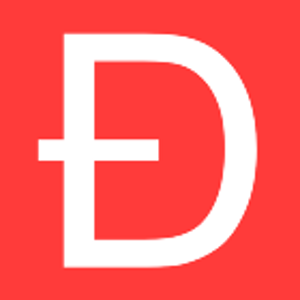
The first major failure of a DAO was TheDao, launched in April of 2016. This project raised over 100 million dollars in the largest crowdfunding event in history, from over 11,000 members. It had the goal of providing decentralized business models for commercial and non-profit businesses, then things went tragically wrong! It was hacked, and funds were drained.
There was a known “recursive call bug” which was under attempts to be fixed at the time of the hack. Devs stated that no funds were at risk. But, during the attempts to fix this bug, an attacker was draining the Ether. 80 million dollars was stolen.
Conclusion
DAOs represent a new type of business structure that improves member coordination. Users can anonymously work towards a common goal, then reap the financial benefits. DAOs also allow users to bet on the financial outcome of a company at its earliest stages, EVEN before venture capital gets a chance. They are a boon to both workers and investors.
As DAO tech progresses, more pieces of management will be automated. This may eventually reach a point where they function with reduced human interaction. But, at this stage DAOs are far from autonomous. I don’t know if DAOs will reach a point of sentience, but currently they seem well-qualified to replace functions of lower level management. There are multiple options to easily start your own DAO. I’m considering starting my own.
HI, if you liked this article please follow me @defipicks!

